C-segment
The C-segment is the third smallest of the European segments for passenger cars and is described as "medium cars".[1][2] It is equivalent to the Euro NCAP "small family car" size class,[3] and the compact car category in the United States.[4]
_%E2%80%93_Frontansicht%2C_23._Dezember_2016%2C_D%C3%BCsseldorf.jpg)
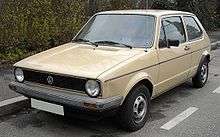
In 2011, the C-segment had a European market share of 23%.[5]
Definition
The European segments are not based on size or weight criteria.[1][6] In practice, C-segment cars have been described as having a length of approximately 4.5 metres (15 ft).[7][8]
The most common body styles for C-segment cars are hatchbacks, sedans and wagons/estates.
Current models
The ten highest selling C-segment cars in Europe are the Volkswagen Golf, Ford Focus, Škoda Octavia, Mercedes A-Class, Peugeot 308, Opel Astra, SEAT León, Toyota Corolla, Renault Mégane and Audi A3.[9]
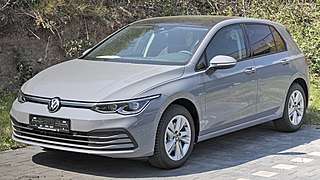 Volkswagen Golf
Volkswagen Golf
(1974–present)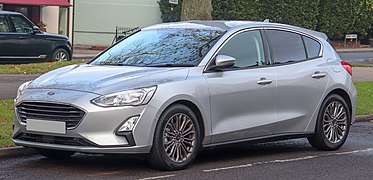 Ford Focus
Ford Focus
(1998–present)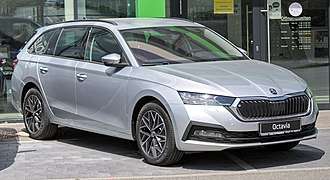 Škoda Octavia
Škoda Octavia
(1996–present) Mercedes-Benz A-Class
Mercedes-Benz A-Class
(1997–present)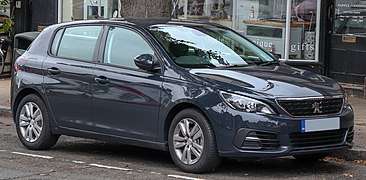 Peugeot 308
Peugeot 308
(2007–present)_%E2%80%93_Frontansicht%2C_13._Oktober_2015%2C_D%C3%BCsseldorf.jpg) Opel/Vauxhall Astra
Opel/Vauxhall Astra
(1979–present) SEAT León
SEAT León
(1999–present)_Ascent_Sport_hatchback_(2018-11-02)_01.jpg) Toyota Corolla
Toyota Corolla
(1966–present)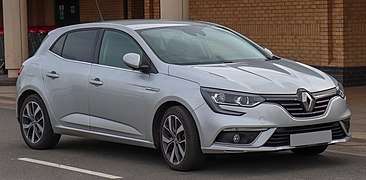 Renault Mégane
Renault Mégane
(1995–present)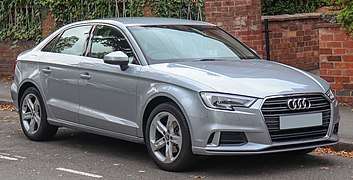 Audi A3
Audi A3
(1996–present)
Sales figures
| 2019 rank | Manufacturer | Model | 2013 sales | 2014 sales | 2015 sales | 2016 sales | 2017 sales | 2018 sales | 2019 sales | % change (2018–2019) |
|---|---|---|---|---|---|---|---|---|---|---|
| 1 | Volkswagen | Golf | 462,527 | 523,729 | 534,535 | 491,681 | 482,177 | 445,303 | 410,779 | |
| 2 | Ford | Focus | 225,102 | 222,297 | 232,160 | 212,083 | 212,353 | 199,197 | 224,401 | |
| 3 | Škoda | Octavia | 165,027 | 205,071 | 215,797 | 226,737 | 227,313 | 216,676 | 218,439 | |
| 4 | Mercedes | A-Class | 131,258 | 121,231 | 119,475 | 141,800 | 143,550 | 153,882 | 198,926 | |
| 5 | Peugeot | 308 | 99,697 | 161,515 | 213,764 | 194,650 | 157,422 | 153,651 | 141,060 | |
| 6 | Opel/Vauxhall | Astra | 198,449 | 179,547 | 192,973 | 250,410 | 216,515 | 158,674 | 136,638 | |
| 7 | SEAT | León | 85,954 | 136,896 | 141,777 | 143,938 | 144,951 | 139,470 | 136,622 | |
| 8 | Toyota | Corolla | 4,714 | 12,432 | 12,713 | 14,030 | 14,382 | 15,041 | 133,597 | |
| 9 | Renault | Mégane | 149,435 | 135,206 | 123,114 | 148,213 | 167,836 | 138,077 | 129,222 | |
| 10 | Audi | A3 | 167,804 | 199,815 | 198,663 | 189,956 | 163,928 | 142,414 | 124,422 |
Europe
According to 2011 sales,[10] compact cars are currently the second segment in Europe after the subcompact one (which in Europe corresponds to A-segment + B-segment), with approximately 3 million units sold.
Because of the Volkswagen Golf's definition and long standing dominance of this class it is often referred to as the "Golf segment" in much of Europe.[11][12][13]
Mainstream compact sedans began falling in popularity since 1990s, when Peugeot stopped production of 306 in 4-door saloon form, and also sharply declining since 2010s, as well as the reduced sales of 4-door Ford Focus.
Compact MPVs
During the late 1990s, compact MPVs increased in popularity as a competitor to the compact car, with models such as the Renault Scenic and the Citroën C4 Picasso becoming popular in Europe.[14] By the early 2010s, demand for compact MPVs was declining, due to the rise of the compact SUV.[15]
History in the United Kingdom
1970s
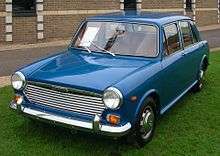
At the start of the 1970s, the two most popular sectors of the UK market were small family cars and large family cars. Since its launch in 1962, the BMC 1100/1300 had often been Britain's best selling car,[16][17] and other locally produced compact cars included the Ford Escort, Vauxhall Viva and Hillman Avenger. Imported small family cars that were popular in the UK included the Citroën GS and Datsun Sunny 120Y.
British Leyland replaced the BMC 1100/1300 with a variety of models; the 1969 Austin Maxi, the 1971 Morris Marina, and the 1973 Austin Allegro.
A second-generation Ford Escort (jointly designed in Britain and Germany) was released in 1974. The same year, the German Volkswagen Golf front-wheel drive hatchback was released, becoming one of the first significantly-imported small family cars in the UK market. The sporty "GTI" version of the Golf sparked a huge demand for "hot hatches" in the UK and many other countries.
The third-generation Vauxhall Viva was produced until late 1979, when it was replaced by the Vauxhall Astra (a rebadged Opel Kadett D which was initially produced in West Germany and Belgium).
The Astra was part of a late-1970s transition in small family cars from being predominantly rear-wheel drive saloons, to becoming front-wheel drive hatchbacks (by then increasingly popular in mainland Europe). The Austin Allegro - introduced five years earlier - was front-wheel drive but was built in only saloon and estate body styles. Only the related Austin Maxi was a hatchback.
The Hillman Avenger (marketed as a Chrysler Avenger 1976-1979 and as a Talbot Avenger 1979-1981) continued to sell well, in spite of the 1978 launch of the Talbot Horizon front-wheel drive hatchback.
1980s
_(cropped).jpg)
The Ford Escort Mk3 went on sale in the autumn of 1980, replacing the rear-wheel-drive saloon format of the Mk2 with a hatchback and front-wheel drive. (A saloon version called the Ford Orion was added in 1983.) Only in 1983 was the Austin Allegro replaced by the Austin Maestro hatchback. In 1984, the Vauxhall Astra Mk2 hatchback/estate/cabriolet was released, alongside a saloon version called the Vauxhall Belmont.
The first significant Japanese-designed compact car in the UK was the 1981 Triumph Acclaim, a licensed version of the four-door Honda Ballade with a Honda-designed engine. The Acclaim was replaced in 1984 by the Rover 200. In late 1985 the Peugeot 309 became the first Peugeot to be built in the UK at the Ryton plant.
1990s

Ford began the 1990s by replacing its 10-year-old Escort (and the Orion saloon version) with the Ford Escort MkV. In 1998, the European version of the Escort was replaced by the global Ford Focus MkI model.
General Motors released the Vauxhall Astra Mk3 update in 1991 and the all-new Astra Mk4 in 1998.
Rover Group introduced the Rover 200 Mk2 in 1989. The Rover 200 Mk3 was introduced in 1995, replacing the Honda Concerto-based Mk2 with a UK-designed car.
See also
References
- "Regulation (EEC) No 4064/89 - Merger Procedure" (PDF). www.europa.eu.
exact market definition was left open .. boundaries between segments are blurred by factors other than the size or length of cars
- "Impact on the Competitiveness of the European Automotive Industry of Potential FTA with India and ASEAN" (PDF). www.europa.eu. p. 8. Archived from the original (PDF) on 29 April 2013.
- "Latest Safety Ratings". www.euroncap.com. Retrieved 8 January 2019.
- "Taking the 'Cheap' Out of the Small Car". The New York Times, September 9, 2012, Phil Patton.
- Christian Thiel; Johannes Schmidt; Arnold Van Zyl; Erwin Schmid (16 February 2014). "Cost and well-to-wheel implications of the vehicle fleet CO2 emission regulation in the European Union". ResearchGate. Transportation Research Part A 63 (2014) 25–42. p. 27+28. doi:10.1016/j.tra.2014.02.018. Retrieved 25 August 2016.
There is no or very little overlap between the traditional segments A to F
PDF EU headliner - "EU: Vehicle Definitions". Retrieved 25 August 2016.
- Meadows, Jordan (2017). Vehicle Design: aesthetic principles in transportation design. Routledge. pp. 39–40. ISBN 9781138685604. Retrieved 29 September 2018.
The [C] segment is around 4.5 metres long.
- Jacobs, Andrew James (2016). The new domestic automakers in the United States and Canada: history, impacts, and prospects. Lexington Books. p. 33. ISBN 9780739188262. Retrieved 19 July 2017.
4) Compact— vehicles between 165 and 179.99 inches in length or equivalent to Europe's C-segment for cars.
- "European car sales data compact car segment - Left-Lane.com". www.carsalesbase.com. Retrieved 6 January 2019.
- "Europe Full Year 2011: Top 318 All models ranking now available!". Automotive News. Retrieved 7 February 2016.
- "Kompaktklasse" [Compact Class] (in German). Auto Motor und Sport. Retrieved 2016-08-19.
- Jakobsson, David; Berggren, Jan-Erik (2013-04-16). "Stort test: De 10 bästa bilarna i Golf-klassen" [Big test: The 10 best cars in the Golf class]. Allt om Bilar (in Swedish). Expressen.
- Copping, Richard (2006). VW Golf: Five Generations of Fun: The Full Story of the Volkswagen Golf. Veloce Publishing. p. 17.
- Speer, Lawrence J. (20 March 2009). "Renault wants to be minivan leader again". Automotive News Europe. Retrieved 7 February 2016.
- "2018's most popular cars in Europe by market segment". www.autocar.co.uk. Retrieved 8 January 2019.
- "BMC 1100/1300 development story – the car that shaped 1960s Britain". www.aronline.co.uk. 17 June 2018. Retrieved 12 January 2019.
- "Buyer's Guide BMC 1100 & 1300 / ADO16 Britain's best-selling". www.drive-my.com. Retrieved 12 January 2019.
_1.4_SE_TSI_hatchback_(2017-08-30).jpg)